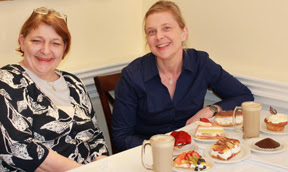 |
| The beautiful Carmel Mission |
Monterey may be the bread basket of America (the Salinas Valley is one of the most fertile places in the country), and home to Cannery Row and the fantastic Monterey Bay Aquarium and neighbor to Carmel and Big Sur, but it’s also home to three historic California Missions, all wildly different, two of which you’ve probably never visited. Many people forget that Spain ruled this area for over 200 years and the Spanish were on California soil in the mid 1500s. It is the chain of 21 Spanish missions that, in essence, created the blue print for what eventually became California. In fact Highway 101 was originally the dirt road that connected the missions known as El Camino Real – “the king’s highway” - and the mission themselves acted as early trading posts and historical repositories.
 |
| Sunday services at Carmel |
San Carlos Borromeo de Carmelo Mission –Carmel’s Crown
Known succinctly Carmel Mission (3080 Rio Rd., Carmel, 831/624-1271,
Daily 9:30 a.m. to 5 p.m., Admission $6.50), is still a very active parish with
regular Sunday services (all three missions offer mass). The large compound
includes an extensive museum with the first known library in California still
on display – courtesy of the mission fathers who were the first librarians and
historians in California as not much else existed in the late 1700s. There are
exhibits of early Native American culture, building materials from the mission
period, vestments and displays on how the friars lived and cooked. The chapel
is more ornate than the other California missions and it’s clear that a lot of money
has been spent on upkeep as the place looks nearly pristine and the grounds are
expansive and beautiful. It can get crowded, making parking out front difficult,
but the mission is just on the outskirts of Carmel.
 |
| Mission San Antonio - the olive tree is at right |
Mission San Antonio de Padua –Lost in Time
The third mission started in California’s chain of 21 is
Mission San Antonio founded in 1771 (Fort Hunter Liggett, 831/385-4478, Jolon, daily
10 a.m. to 4 p.m., Admission $3). It’s commonly referred to as “the mission
that time forgot” and that’s unfortunate, but here’s why - it’s 25 miles off
Highway 101. The location is remote and it sits on the Fort Hunter Liggett U.S. Army base which the public can access
(have your drivers’ license and proof of insurance ready – you cannot get on
base without them). Look for the original brick wine vat, constructed between
the late 1700s early 1800s, which uses a gravity flow system. This was one of
the first missions to produce wine and the interior courtyard has a large vine
by the well which is originally from Spain, lugged over here when the missions
were founded. Several other rooms display artifacts like embroidered vestments,
mission era tools and priests’ quarters.
 |
| This grapevine was brought over from Spain by the padres |
There are also remnants of the old
waterworks and a beautiful large olive tree planted in 1846 right out front.
The church itself is longer than most, but simply decorated, with painted
wainscoting along the walls. The mission was damaged in a recent earthquake and
the race is on to raise money for much needed restoration or else it will be
shuttered, and we’d hate to lose a valuable piece of history. You may say toy
yourself: why should I drive all the way out there to visit just an old
mission? Well, aside from the historical significance, also located nearby is
the old Hearst Hacienda – a ranch
house on the former William Randolph Hearst property, designed by Julia Morgan and where Hearst would
take his guests (Clark Gable and Errol Flynn stayed here) on horseback
who were sojourning at the Hearst Castle.
The Army bought it from Hearst in 1940 but you can stay the night here in one
of the old ranch rooms. They are pretty Spartan, but you can also access the
military bowling alley nearby for some food and maybe bowl a frame with a general.
Room rates range from $50 to $95. You need to contact the Morale, Welfare and
Recreation division of Fort Hunter Liggett and make reservations directly with
them.
 |
| The Hearst Hacienda |
Mission Nuestra Senora de la Soledad –Solitude in Soledad
Founded in 1791, Mission Soledad (36641 Fort Romie Rd., Soledad,
831/678-2586, daily 10 a.m. to 4 p.m., free admission) was the 13th
in the chain of 21 missions. It too is one of the least visited missions even
though it’s less than three miles off Highway 101 in Soledad (take the Arroyo
Seco exit off Highway 101) and is an easy visit on the way to several of the
area wineries.
 |
| Mission Soledad |
Every October there is a wine auction from mainly local wineries
to raise money for restoration. The chapel is one of the smallest and most
simple I have visited in the mission chains and the humble structure is
surrounded by crop fields and you can see vineyards of the wineries in the Santa Lucia Highlands in the distance.
It’s small and not as postcard-pretty as California’s other missions. The
original mission was badly damaged in the floods of 1828, and wasn’t
reconstructed until the early 1950s. But the original adobe walls can still be
seen; mounds of rounded earth returning to the dirt from whence they came. In
its day, the mission hosted a vineyard, fruit trees, and herds of cattle. There
are a few rooms of artifacts on display from the mission days.
 |
| The original Mission Soledad walls |
and make sure when you come
to Monterey you find time to visit these missions as they are the link to
California’s illustrious past.Contact them here:
Hearst Hacienda: (831) 386-2262











































